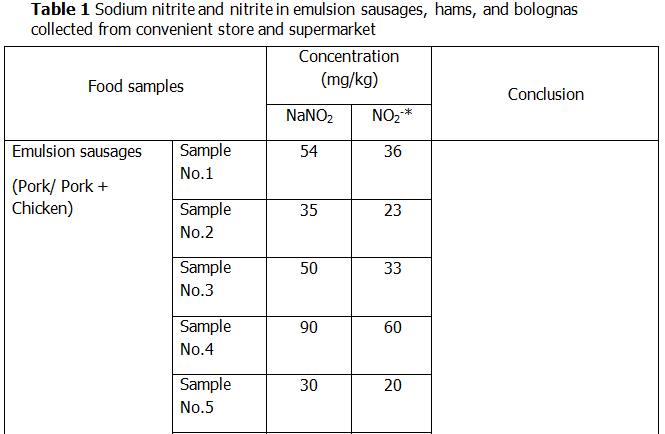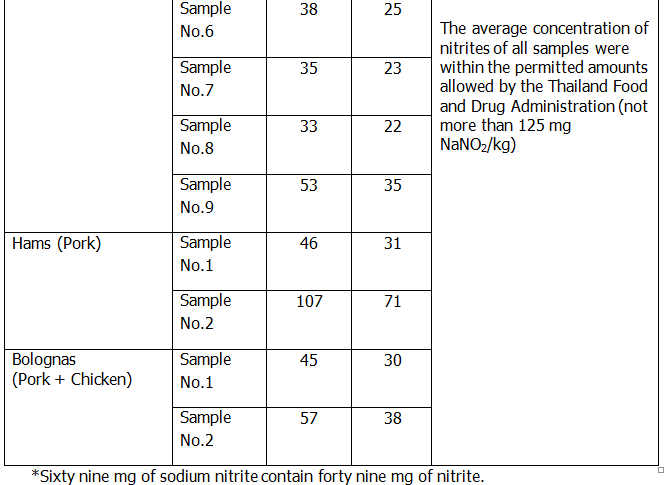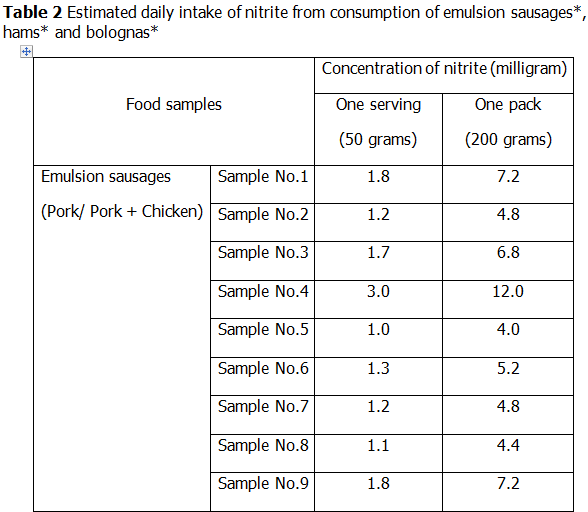
|
Eng |
Nitrite in cured meat products
Emulsion-type sausages, hams and bolognas are cured meat products, which are very popular meals among students due to their appealing appearance, flavor and texture. In order to prolong the shelf life of these low acid food products, preservatives are used in processed meats, along with low temperature, vacuum packaging and other techniques to increase shelf life and other food technology reasons. Potassium and sodium nitrite are the most common preservatives used due to their ability to inhibit the growth of Clostridium botulinum. Nitrites (NO2-) will also combine with myoglobins (natural pigments in muscle cells) to form nitrosylmyoglobins which during normal cooking will be thermally converted to nitrosylhemochromes, which gives the pink color in these ready to eat meat products. The minimum amount of nitrite, used as a color fixation agent and also as a preservative, ranges from 20 to 100 milligram per kilogram. According to Thailand regulations, the permitted amount of nitrite in cured meat products is not more than 125 milligrams per kilogram. However, the 2013 Thailand epidemiological surveillance report revealed that 8.4% of emulsion-type sausages and 16.9% of Chinese sausages sold in markets contained nitrite amounts that exceed the legal limits.
During March–April 2015, the Department of Food Chemistry, Faculty of Pharmacy at Mahidol University, randomly collected 13 samples of cured meat products sold at convenient stores and supermarkets in order to determine their nitrite content. Based on the spectrometric quantitative analysis of nitrite (Modified AOAC official method 973.31), the average concentration of nitrites (as mg NaNO2/kg) of all samples were within the permitted amounts allowed by the Thailand Food and Drug Administration (as shown in Table 1). 

Toxicology of nitrite:
The adverse effects of nitrite on human health have been studied by using lab animals. One study reported that lab rats used in an experiment, which were fed high amounts of nitrite (250-2,000 mg/kg) showed higher risk of developing lymphatic cancer. Nitrite has the ability to combine with stomach acid and then convert itself to nitrous acid (HNO2). Nitrous acid reacts subsequently with an amine or amide compound (normally existing in the protein portion of the ingested meal) to form an endogenous nitrosamine. Nitrosamine is known as a carcinogenic substance which can trigger cancer formation in the body. Epidemiological studies have shown that high nitrite intake can lead to cancer formation in the esophagus and stomach.
The acute symptoms of immediate nitrite overdose include green coloration of skin and nails, and the high increase of heart rate. These acute symptoms may become fatal because nitrite can attach itself to hemoglobin to form metheamoglobin which does not have the same ability to bind oxygen molecules as hemoglobin does. The lethal amount of nitrite intake is 32 milligrams per 1 kilogram of body weight. In Thailand, there were two reported incidents of methemoglobinemia which were related to consumption of emulsion chicken sausages (containing 3,137 mg NaNO2/kg) and fried chicken marinated with high amount of nitrite.
According to JECFA (Joint WHO/FAO Expert of Committee on Food Additive, 2002), the acceptable amount of daily intake (ADI) of nitrite is 0.0-0.7 milligrams per 1 kilogram. Based on the average body weight, the calculation reveals that the safe amount of daily intake of nitrite from food should not exceed 3.1 milligrams in teenagers (9-18 years old, 44.5 kilogram) and 3.8 milligrams is adults (?19 years old, 54.5 kilogram). Table 2 shows the estimated daily intake of nitrite from the consumption of one serving (50 grams) and one purchased unit (200 grams) of the selected commercial emulsion-type sausages, ham and bologna (as shown in Table 1).
According to this study, even though sausages, ham and bologna contain nitrite within the required limits, consumption of the entire purchased unit at one time (200 grams) can be harmful to human health. It is best to limit daily consumption to only 50 grams (1 serving) at a time or at a maximum of 2 servings (100 grams). 
